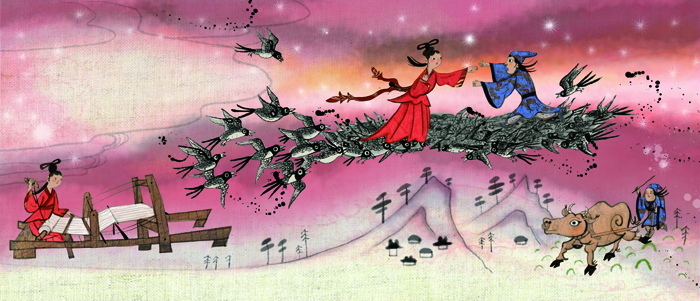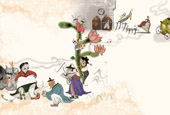View this article in another language
- 한국어
- English
- 日本語
- 中文
- العربية
- Español
- Français
- Deutsch
- Pусский
- Tiếng Việt
- Indonesian
This is a story of star-crossed lovers—quite literally: a tale of both great beauty and tremendous sadness. It begins with the Sky King, or Ruler of the Universe, who had a daughter named Jingnyeo, which translates as “weaver girl.” In addition to being a loyal daughter, Jingnyeo was also a very diligent weaver. One day, however, the Sky King sensed in her a deep loneliness. In order to make her happy, he introduced her to Gyeonu, whose name translates as “cow herdsman.” The two quickly fell in love and, under the King’s blessing, got married.
Too Much of a Good Thing
It looked as if the two would live happily ever after, for they could hardly bear to be out of each other’s sight. Their passion was beautiful beyond description, their rapture beyond measure. In fact, the newlyweds were so completely absorbed in one another that they neglected everything else outside their romance. Jingnyeo stopped weaving, leaving the King and his servants with no cloth, and Gyeonu left his herd unattended, leaving the cows to wander throughout the galaxy in disarray. The King was furious, and decided that the pair’s behavior revoked their privilege of being together. He separated them by putting them on opposite sides of the Milky Way—a star arrangement often described in mythology as a celestial river—with Jingnyeo in the West and Gyeonu in the East.

Devastated, the two cried and grieved unceasingly, their wails of despair echoing throughout the heavens. The distanced lovers are represented in today’s night skies by the stars of Altair (Gyeonu) and Vega (Jingnyeo). The sounds of sadness and heartbreak emitted by the cursed couple reverberated down to Earth, where it deeply moved all the magpies and ravens, inspiring them to fly up to the heavens once a year to form a bridge across the Milky Way, thus providing a precious respite amid the accursed lovers’ separation.
This annual reunion between Gyeonu and Jingnyeo occurs on the seventh day of the seventh month in the Lunar Calendar, known as Chilseok, or “Seventh Moon” in Korean—a time when the movements of both stars lend the illusion of them meeting at the top of the sky. Folklore commonly describes any raven or magpie that remains on Earth on this day as either sick or dying. Additionally, if it rains on the evening of Chilseok, one can witness the tears of the reunited lovers’ happiness and glee. The rain that commonly appears on the morning afterward, however, are the tears of grief and heartbreak the lovers shed as they prepare to part for another year.
A Celebration of Love
This poetic tale is commonly said to have been passed down from an ancient Chinese legend, with a version also existing in Japanese folklore. In the lunar calendar, July 7 also has its own festival in honor of the pining lovers, a celebration of our love for those dear to us. It is known as the Qixi Festival in China, the Tanabata Festival in Japan and the Gyeonu and Jingnyeo Festival in Korea. The event draws couples from all over the country, encouraging them to celebrate their affection for each other while giving thanks for not being separated by an obstacle as vast as the Milky Way.
Although the term “star-crossed” lovers was coined by Shakespeare to describe Romeo and Juliet, it also conveniently happens to be the perfect term to describe the two stars in our night sky that can only convene once a year, Altair and Vega. So which couple is more tragic: Romeo and Juliet, whose love was terminated by suicides rooted in misunderstanding? Or Gyeonu and Jingnyeo, whose unfaltering passion for each other cursed them to remain separated forever, save for that one precious day a year?
Written by Felix Im
Illustrated by Shim Soo-keun
*The series of old Korean tales has been made possible with the cooperation with Korea Magazine.
Too Much of a Good Thing
It looked as if the two would live happily ever after, for they could hardly bear to be out of each other’s sight. Their passion was beautiful beyond description, their rapture beyond measure. In fact, the newlyweds were so completely absorbed in one another that they neglected everything else outside their romance. Jingnyeo stopped weaving, leaving the King and his servants with no cloth, and Gyeonu left his herd unattended, leaving the cows to wander throughout the galaxy in disarray. The King was furious, and decided that the pair’s behavior revoked their privilege of being together. He separated them by putting them on opposite sides of the Milky Way—a star arrangement often described in mythology as a celestial river—with Jingnyeo in the West and Gyeonu in the East.

Devastated, the two cried and grieved unceasingly, their wails of despair echoing throughout the heavens. The distanced lovers are represented in today’s night skies by the stars of Altair (Gyeonu) and Vega (Jingnyeo). The sounds of sadness and heartbreak emitted by the cursed couple reverberated down to Earth, where it deeply moved all the magpies and ravens, inspiring them to fly up to the heavens once a year to form a bridge across the Milky Way, thus providing a precious respite amid the accursed lovers’ separation.
This annual reunion between Gyeonu and Jingnyeo occurs on the seventh day of the seventh month in the Lunar Calendar, known as Chilseok, or “Seventh Moon” in Korean—a time when the movements of both stars lend the illusion of them meeting at the top of the sky. Folklore commonly describes any raven or magpie that remains on Earth on this day as either sick or dying. Additionally, if it rains on the evening of Chilseok, one can witness the tears of the reunited lovers’ happiness and glee. The rain that commonly appears on the morning afterward, however, are the tears of grief and heartbreak the lovers shed as they prepare to part for another year.
A Celebration of Love
This poetic tale is commonly said to have been passed down from an ancient Chinese legend, with a version also existing in Japanese folklore. In the lunar calendar, July 7 also has its own festival in honor of the pining lovers, a celebration of our love for those dear to us. It is known as the Qixi Festival in China, the Tanabata Festival in Japan and the Gyeonu and Jingnyeo Festival in Korea. The event draws couples from all over the country, encouraging them to celebrate their affection for each other while giving thanks for not being separated by an obstacle as vast as the Milky Way.
Although the term “star-crossed” lovers was coined by Shakespeare to describe Romeo and Juliet, it also conveniently happens to be the perfect term to describe the two stars in our night sky that can only convene once a year, Altair and Vega. So which couple is more tragic: Romeo and Juliet, whose love was terminated by suicides rooted in misunderstanding? Or Gyeonu and Jingnyeo, whose unfaltering passion for each other cursed them to remain separated forever, save for that one precious day a year?
Written by Felix Im
Illustrated by Shim Soo-keun
*The series of old Korean tales has been made possible with the cooperation with Korea Magazine.

